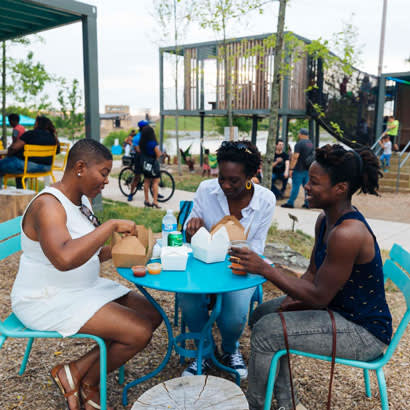
Pictured left: A group shares a meal at River Garden in Memphis, Tennessee. Photo by Ziggy Mack, courtesy of Memphis River Parks Partnership.
Since 2016, Memphis, Tennesee, has been working on transforming its Mississippi Riverfront from miles of underutilized public space into a series of connected parks, gathering places and civic spaces that are both vibrant and welcoming. It’s working: visitors to one signature park, River Garden, have increased 267 percent in five years.
A core goal for much of this work in Memphis has been intentionally attracting economically and racially diverse visitors into these reimagined public spaces, to capitalize on the benefits of what’s called “socioeconomic mixing.” Research has shown that generating even casual interactions among people with diverse economic, racial and ethnic backgrounds can benefit individuals and communities: increasing trust, cooperation and generosity and creating an improved sense of well-being and safety. In fact, the casual interactions we have with others are as important to our well-being as our interactions with family and friends.
Perhaps the most significant findings about the benefits of socioeconomic mixing are from Harvard economist Raj Chetty, whose recent research shows that cross-class interactions and connections are key to upward economic mobility. Children who grow up in communities with more economic connectedness (connections across classes) are much more likely to rise up out of poverty.
Our public parks, community centers and greenspaces turn out to be excellent places to foster these cross-class interactions.
Memphis’ River Garden park started as an uninspired, underused public space named after Jefferson Davis, the president of the Confederacy. Renamed, redesigned and reopened in late 2018, the park is now a popular, go-to place in downtown Memphis. With a dining and events pavilion, all-ages play and adventure structure, natural meadow plantings, fire pits, a snack shack, swings, hammocks, tables and differently scaled conversation spaces, it is successfully attracting not just more people, but more diversity. Surveys of visitors show that the park’s users hail from a wide range of socioeconomic backgrounds and from a diverse geography of more than forty different zip codes.
While many public spaces seek to separate users and activities, River Garden encourages visitor activity in one portion of the park, fostering more interaction among visitors and increasing the opportunity for people of different backgrounds to connect whether they are climbing on the treehouse or grabbing a cup of coffee from the coffee stand.
Former park maintenance staff have been retrained as park rangers who greet visitors and make the parks welcoming to everyone, in addition to their daily maintenance tasks. Free, regular and low-barrier-to-entry programming and activities draw in people with varied interests. New signage, and forthcoming infrastructure upgrades, help to create safer and more visible walk/bike corridors between the riverfront and surrounding neighborhoods.
In our work, we’ve seen many other cities across the country learn valuable lessons about encouraging and increasing socioeconomic mixing, including:
- Quality matters. Public spaces must aim to be ‘best in class’ in order to compete with private alternatives for recreation, relaxation and free time. By holding a high standard for public places, we create a greater potential to attract a mix of visitors from different backgrounds.
- Work to attract people from multiple neighborhoods. Too often, public spaces focus on attracting people from one neighborhood, but economic and social segregation in those neighborhoods make it difficult to achieve true socioeconomic mixing. For public spaces to draw diverse users, they must intentionally attract residents from multiple neighborhoods.
- Vary your programming. A variety of interesting experiences in one place works better to attract visitors of all ages and backgrounds, and encourages repeat visits and repeated interaction. Clustering different events and elements in close proximity to one another encourages interactions among visitors who may otherwise not have an opportunity to meet.
- Go beyond events. While large events can offer instances of socioeconomic mixing, more lasting impact comes from programs that offer simpler, everyday moments for people of different backgrounds to connect with each other and form relationships. A daily walking club, a weekly yoga class, a semimonthly market day or even watching the sunset as a community can create these much-needed connections.
- Staff are crucial to the visitor experience. Staff roles and responsibilities should include acting as ambassadors to your space, which sets the tone to encourage encounters between visitors, help visitors understand differences between people and, if necessary, resolve conflicts in ways that do not require law enforcement.
- Measure your progress. Adopting socioeconomic mixing as a goal and measuring performance towards that goal is critical for ensuring diversity remains central to the design, operations and management of public space. Measuring the Civic Commons is a free tool that can be used to collect and analyze data to understand your public space’s performance in terms of socioeconomic mixing.
For more information about ways to create shared experiences among people of all incomes and backgrounds in your public spaces, download Investing with Intention: Socioeconomic Mixing.
Bridget Marquis (she/her) is the Director of the Reimagining the Civic Commons Learning Network. She is passionate about the potential for our public spaces to bring us together across divides and deliver social outcomes for cities. You can follow her on Twitter and LinkedIn.

